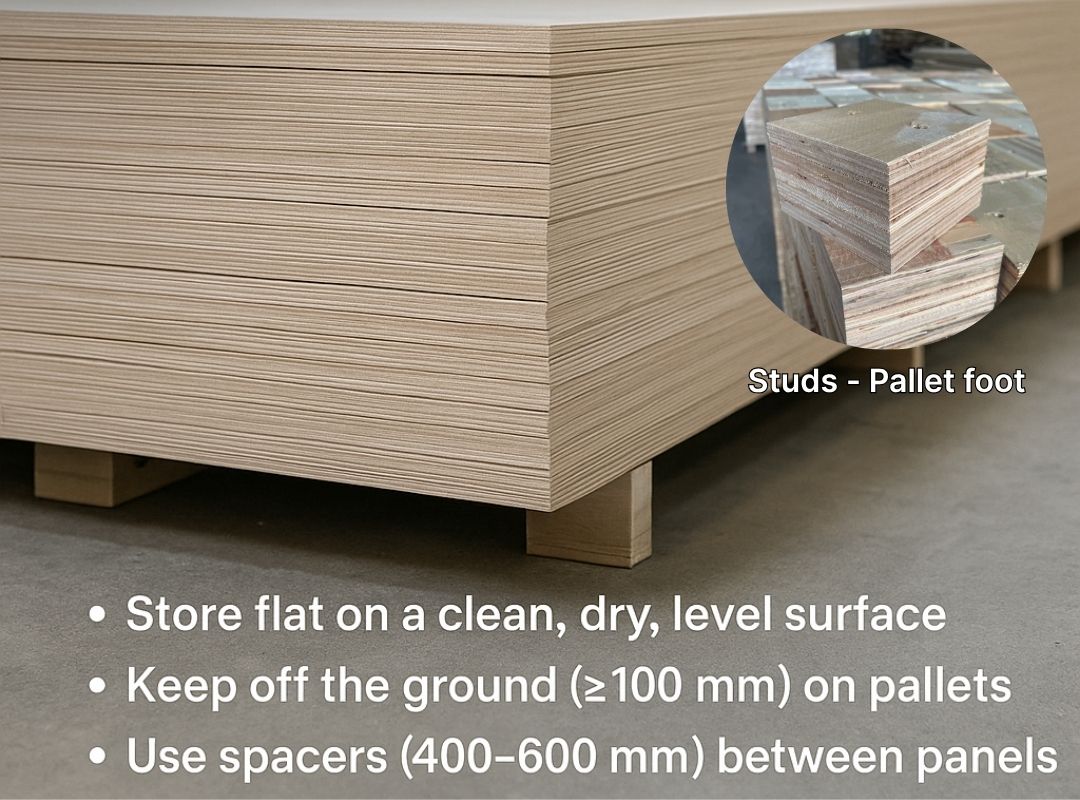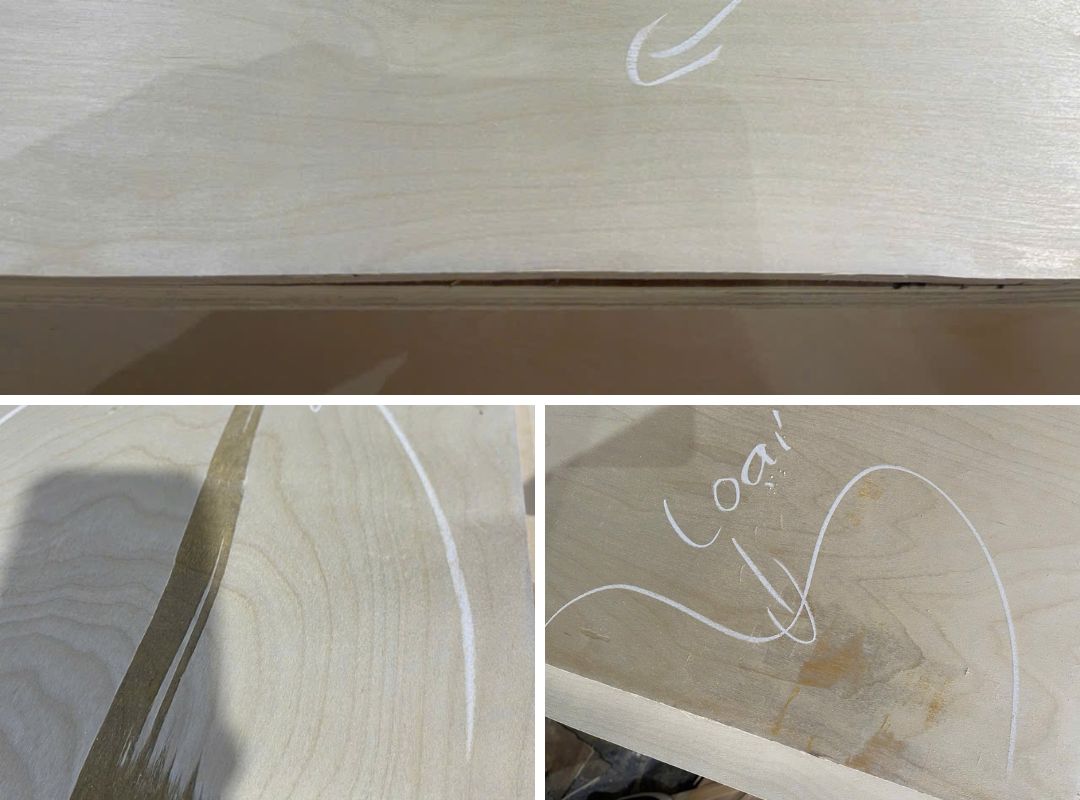-
-
-
Total payment:
-

How to Store Birch Plywood On-Site: Prevent Damage & Cut Waste
Posted by Thanh Uyên at 28/10/2025
1. The Hidden Cost of Poor Storage
Even the best-quality Birch Plywood can fail when stored incorrectly. A few days of moisture exposure or uneven stacking can lead to warping, edge cracks, and delamination turning valuable stock into waste.
In the EU and US, where precision and compliance standards are high, importers and contractors often overlook one critical factor: on-site handling and storage. Whether your plywood comes from Finland or Vietnam, maintaining optimal storage conditions is as essential as choosing the right grade or adhesive.
In this guide, we explain how to protect Birch Plywood on-site, from delivery to final installation, ensuring every panel performs exactly as intended.
2. Why Birch Plywood Needs Special Care
Birch Plywood is engineered for strength and visual appeal. It’s composed of multiple cross-laminated veneers bonded under heat and pressure, producing a dense panel (~650–700 kg/m³).
While durable in use, Birch remains susceptible to moisture and temperature swings before installation. This is because:
- Veneer edges can absorb humidity quickly.
- Stacked panels trap condensation when stored on damp floors.
- Uneven weight distribution can distort layers over time.
Proper storage isn’t optional - it’s the key to preserving both appearance and dimensional accuracy.
👉 Related reading: Vietnamese Birch Plywood: The Smart Alternative to Baltic Birch
3. Understanding Common On-Site Damage
Before we discuss prevention, it helps to know what typically goes wrong.
| Type of Damage | Cause | Impact |
|---|---|---|
| Warping | Stored flat on uneven ground or under moisture | Reduces fit accuracy during installation |
| Edge Swelling | Absorbs water from floor or air | Visible bulging and peeling on face veneer |
| Delamination | Repeated humidity cycles | Structural weakness and loss of bonding |
| Mold and Discoloration | Condensation and poor ventilation | Aesthetic defects and odor |
These issues often develop slowly unnoticed until assembly or finishing, when replacement becomes expensive.
4. Best Practices for Storage on Construction or Workshop Sites

4.1. Prepare the Storage Area
The foundation of good plywood storage is a clean, dry, and level surface. Avoid direct contact with concrete floors or exterior walls.
- Maintain humidity between 40–60% and temperature around 18–25°C.
- Use timber blocks or pallets (minimum 100 mm high) to raise stacks off the ground.
- Ensure air circulation between stacks and walls.
4.2. Stack Panels Correctly
Improper stacking is one of the fastest ways to warp plywood.
Follow these guidelines:
- Always lay sheets flat, never leaned against a wall.
- Align edges perfectly to distribute load evenly.
- Place spacers every 400-600 mm across the stack width to support weight.
- Keep protective packaging (film or corner covers) until panels are ready to use.
When possible, store full pallets rather than loose sheets minimizing exposure to air and mechanical stress.
5. Weather and Moisture Protection
When working outdoors or near open loading zones, follow these moisture-control steps:
- Cover, don’t seal: Use breathable waterproof covers like tarpaulin never plastic wrap, which traps humidity.
- Ventilate stacks: Allow air to circulate through the sides to prevent condensation.
- Monitor site drainage: Avoid storing plywood near areas prone to rain splash or flooding.
- Inspect daily: Especially after storms or overnight temperature drops.
These small actions can prevent thousands of euros in material loss each year.
6. Handling and Transportation Tips
Even before storage, handling matters:
- Lift panels vertically with two or more workers to avoid edge damage.
- Use fork extensions for full sheet support when unloading.
- Avoid dragging sheets across rough or wet surfaces.
- Always re-stack panels after partial removal to maintain balance.
By training staff on these steps, importers and contractors can reduce handling damage by up to 35%, based on industry case studies.
7. Indoor vs. Outdoor Storage
Not all projects have the luxury of indoor warehouses, but climate-controlled storage is ideal. Indoors, the risk of swelling and delamination drops dramatically.
For outdoor sites:
- Choose elevated platforms.
- Cover stacks with sloped roofing sheets.
- Use weighted covers to prevent wind uplift.
- Schedule first-in, first-out (FIFO) rotation to minimize time exposed to the elements.
Remember: Birch Plywood absorbs moisture faster through its edges than its surface sealing edges with water-resistant coatings can significantly extend usability.
8. The Role of Sealing and Surface Protection
Factory-sealed edges with melamine or phenolic film resist water intrusion. If your plywood isn’t pre-sealed, apply a thin coat of wood sealer or polyurethane to all edges before storage.
TT Plywood’s birch range includes both raw sanded and pre-sealed variants, designed for humid or coastal climates. This provides flexibility for importers in regions with high seasonal humidity from Northern Europe to the U.S. East Coast.
👉 Related reading: Vietnam’s FSC Plywood: The New Alternative to Costly Chinese Imports
9. Waste Reduction and Quality Control
Proper on-site storage can reduce waste dramatically. Warped or swollen panels can’t be reused for visible surfaces, leading to reordering costs and delays.
Three key practices to cut waste:
- Rotate inventory weekly to maintain airflow.
- Inspect every batch before cutting or assembly.
- Document moisture readings using a hygrometer (≤12% is ideal).
For large importers, maintaining a storage logbook helps track environmental conditions and material rotation, ensuring compliance with project quality standards like ISO 9001 or FSC Chain of Custody.
10. Cost Impact: The Economics of Proper Storage
Studies from European construction associations show that improper plywood storage accounts for 8–12% of total material loss on large projects.
Assume a shipment of 60 m³ Birch Plywood valued at €750/m³ that’s a potential €5,000–€7,000 wasted simply due to poor stacking or moisture exposure. By contrast, investing in raised pallets, covers, and moisture meters costs a fraction of that.
Good storage isn’t just good practice; it’s an immediate return on investment.
Birch Plywood is one of the most versatile, durable materials available but only when treated right. From factory to installation, protection determines performance.
TT Plywood supports importers, contractors, and manufacturers with premium Vietnam Birch Plywood engineered for resilience and consistency. Every shipment is packaged for export, sealed against humidity, and accompanied by clear storage and handling instructions.
Contact TT Plywood today for technical guidance or to request our Plywood Handling & Storage Manual for your next shipment. Preserve quality. Cut waste. Build smarter.
📞Hotline/WhatsApp/Line/Kakao: +84 32 694 2288
📧Email: info@ttplywood.com
🌐Website: https://ttplywood.com/
FAQs
Q1: Can I store Birch Plywood vertically?
No. Always store sheets flat to prevent bending and edge cracking.
Q2: How long can plywood stay in temporary storage?
Up to 3–6 months indoors with controlled humidity; less than 1 month outdoors unless sealed and elevated.
Q3: Should I remove factory wrapping immediately?
Not until the panels are acclimatized and ready for use. The packaging helps control moisture transition.
Q4: What’s the ideal moisture level for plywood before machining?
Below 12%. Always check with a calibrated wood moisture meter before cutting.
Conclusion
Storing Birch Plywood properly is as essential as selecting the right grade. The right environment level, ventilated, and dry preserves structure, appearance, and profitability.
From high-end cabinetry to large construction formwork, preventing damage starts the moment plywood arrives on-site. With the right storage practices, you can extend material life, reduce waste, and maintain the professional standards your clients expect.
For consistent quality and expert export packaging, choose TT Plywood - a trusted partner in delivering Vietnam Birch Plywood that performs perfectly from port to project.
References
BS EN 636:2015. Plywood – Specifications. London: British Standards Institution.
FAO (2023). Moisture and Storage Guidelines for Engineered Wood Panels. Food and Agriculture Organization of the United Nations.
TT Plywood (2025). Vietnamese Birch Plywood: The Smart Alternative to Baltic Birch. Available at: https://ttplywood.com/vietnamese-birch-plywood-the-smart-alternative-to-baltic-birch (Accessed: 26 October 2025).











